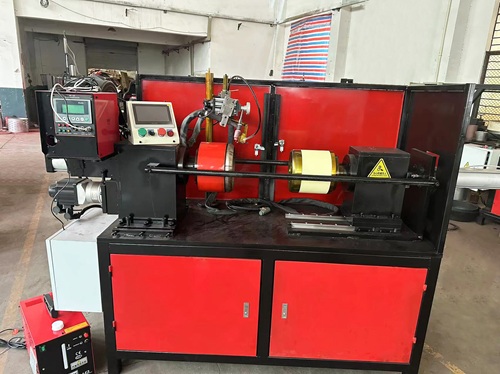In the manufacturing of stainless steel beer kegs, welding machines play a critical role in ensuring structural integrity, hygienic performance, and long service life. Welding processes are used to join keg components such as the top and bottom chimes, body cylinders, and neck fittings. This article focuses on the welding machine used in keg production, analyzing its working principle, usage procedures, as well as its advantages and limitations.
1. Working Principle of the Welding Machine
In beer keg production, TIG (Tungsten Inert Gas) welding—also known as GTAW (Gas Tungsten Arc Welding)—is most commonly employed due to its precision and clean welds. Some production lines also use laser welding or plasma welding for higher automation and speed.
TIG Welding Principle:
A non-consumable tungsten electrode generates an arc that melts the base metals. An inert gas (usually argon) shields the weld area from oxidation and atmospheric contamination. The filler rod may or may not be used depending on the joint type.Laser Welding Principle:
A high-powered laser beam is focused on the joint, melting the metals rapidly with minimal heat-affected zone. It allows for deep penetration and high-speed continuous welding.Plasma Welding Principle:
Plasma welding is a variation of TIG welding where a constricted arc is formed, allowing for higher energy density and deeper weld penetration.
2. How the Welding Machine is Used in Keg Manufacturing
The welding process typically involves the following steps:
Component Preparation:
All keg parts are cleaned, aligned, and clamped into position. Oxide films and contaminants are removed.
Parameter Setting:
Operators set key parameters such as current, voltage, gas flow rate, and travel speed according to the material thickness (usually SUS304 stainless steel, 1.2–2.0 mm).
Welding Execution:
Manual or semi-automatic TIG welding may be used for small batch or repair work.
Fully automatic orbital or circumferential welding is applied in high-volume production for consistent and repeatable results.
The weld is typically continuous along the circumference of the joint with precise control.
Post-Weld Processing:
Includes weld inspection (visual, X-ray, or dye penetrant testing), pickling/passivation, and pressure/leak tests.
3. Advantages of the Welding Machine in Keg Production
High Precision and Clean Welds:
Particularly important in food and beverage applications where hygiene is critical.Excellent Metallurgical Quality:
The use of inert gas shielding prevents contamination and ensures strong, corrosion-resistant joints.Automation Capability:
CNC-controlled welding machines enable high productivity and consistent quality across large production batches.Adaptability to Thin-Walled Stainless Steel:
TIG and laser welding methods are especially suitable for welding thin-gauge materials with minimal distortion.
4. Disadvantages and Limitations
High Initial Investment:
Laser and automatic TIG welding machines are capital-intensive and require skilled maintenance.Slow Speed (TIG):
Compared to other welding methods, TIG welding is relatively slow, affecting overall throughput in some settings.Operator Skill Requirement:
Manual TIG welding demands significant expertise for high-quality results, especially for sanitary welds.Maintenance Complexity:
Precision machines, especially laser welders, require regular calibration and careful environmental control.
5. Conclusion
The welding machine used in beer keg manufacturing is a cornerstone of the production process, ensuring durable and leak-proof containers. While traditional TIG welding remains widely used due to its cleanliness and precision, more advanced methods like laser and plasma welding are gaining popularity for their speed and automation potential. Despite their costs and complexity, these machines provide unmatched benefits in product quality and manufacturing efficiency, making them indispensable tools in the modern brewery equipment industry.


